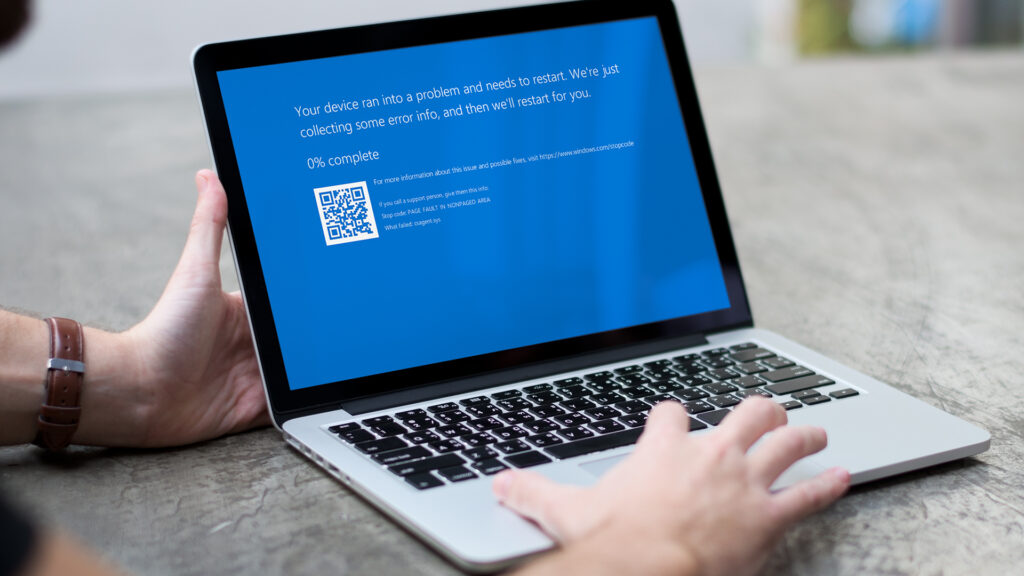BC Networks: Blog

Lessons to Learn from the CrowdStrike Outage
The recent CrowdStrike outage serves as a significant wake-up call for businesses relying on cybersecurity solutions. CrowdStrike’s temporary service disruption, as one of the leading providers of endpoint security, underscores the importance of preparedness and resilience in the face of unexpected technological failures. This incident provides valuable insights into how businesses can strengthen their own cybersecurity posture and ensure continuous protection.
What Happened?
CrowdStrike, known for its robust endpoint protection solutions, experienced a significant outage that affected many of its customers. The disruption was primarily caused by technical issues within their data centers. These issues led to service unavailability, preventing businesses from accessing critical security functions and exposing them to potential vulnerabilities. While CrowdStrike promptly addressed the issue, the incident highlighted the need for enhanced resilience and preparedness in cybersecurity infrastructures.
Key Lessons to Learn from the CrowdStrike Outage
The Importance of Redundancy
One of the most crucial lessons from the CrowdStrike outage is the necessity of redundancy in cybersecurity infrastructure. Redundancy involves having multiple, independent systems in place to ensure that if one fails, others can take over. Businesses should implement backup solutions and alternative security measures to avoid single points of failure. This could include having multiple security vendors, diverse authentication mechanisms, and alternative communication channels. Ensuring that critical systems have failover mechanisms can significantly reduce the impact of outages.
Proactive Incident Response Planning
An effective incident response plan is essential for minimizing the impact of outages and breaches. CrowdStrike’s swift communication and remediation efforts highlighted the importance of being prepared. Businesses should develop and regularly update incident response plans that include clear steps for identifying, containing, eradicating, and recovering from security incidents. Conducting regular drills and simulations can ensure that all team members know their roles and responsibilities during an actual event. Having a well-rehearsed plan can make the difference between a minor inconvenience and a major crisis.
Continuous Monitoring and Real-Time Alerts
The CrowdStrike outage demonstrated the value of continuous monitoring and real-time alerts. Businesses should invest in robust monitoring tools that provide real-time visibility into their systems and networks. These tools can help detect anomalies and potential threats early, allowing for quicker response times. Additionally, setting up automated alerts can ensure that critical issues are promptly addressed, reducing downtime and mitigating damage. Continuous monitoring also helps in maintaining a proactive approach to security rather than a reactive one.
Communication is Key
Transparent and timely communication was a key factor in how CrowdStrike managed its outage. Effective communication with customers, stakeholders, and employees during a cybersecurity incident is vital. Businesses should establish communication protocols that ensure accurate information is disseminated quickly. This includes updating customers on the status of the incident, providing guidance on any necessary actions, and maintaining trust through honesty and transparency.
Regular System Updates and Patching
Keeping systems and applications up-to-date is a fundamental aspect of cybersecurity. The CrowdStrike outage serves as a reminder of the importance of regular updates and patching. Businesses should implement a robust patch management process to ensure that all software and hardware are current and vulnerabilities are addressed promptly. Automated patching tools can help streamline this process and reduce the risk of human error.
Third-Party Risk Management
CrowdStrike’s outage also highlights the risks associated with third-party vendors. Businesses must assess and manage the risks posed by their third-party service providers. This involves conducting thorough due diligence before engaging with vendors, continuously monitoring their performance and security practices, and having contingency plans in place in case a vendor experiences a disruption. Establishing clear contractual agreements that outline service-level expectations and response protocols can further mitigate third-party risks.
Investing in Robust Cybersecurity Solutions
While no system is immune to outages, investing in high-quality cybersecurity solutions can significantly enhance a business’s resilience. The CrowdStrike outage underscores the need for comprehensive security tools that provide layered protection. Businesses should evaluate their security needs and invest in solutions that offer advanced threat detection, automated response capabilities, and extensive support options. Regularly reviewing and updating security investments can help maintain an optimal security posture.
Employee Training and Awareness
Human error remains one of the leading causes of cybersecurity incidents. Ensuring that employees are well-trained and aware of security best practices is crucial. The CrowdStrike outage serves as a reminder to prioritize cybersecurity training programs that educate employees about recognizing and responding to threats, following secure practices, and reporting suspicious activities. Regular training sessions and simulated phishing exercises can reinforce this knowledge and improve overall security awareness.
Business Continuity Planning
Business continuity planning is essential for ensuring that operations can continue during and after a cybersecurity incident. The CrowdStrike outage highlights the importance of having a comprehensive business continuity plan that includes strategies for maintaining critical functions, recovering data, and restoring services. Businesses should regularly test and update their continuity plans to ensure they remain effective in the face of evolving threats.
Learning from Incidents
Finally, learning from incidents is a vital part of improving cybersecurity resilience. The CrowdStrike outage provides valuable insights that businesses can use to enhance their own security measures. Conducting post-incident reviews to analyze what went wrong, what worked well, and how processes can be improved is essential. By learning from past incidents, businesses can strengthen their defenses and reduce the likelihood of future disruptions.
Moving Forward with Enhanced Security
The CrowdStrike outage serves as a powerful reminder of the complexities and challenges of maintaining robust cybersecurity. By learning from this incident and implementing the lessons outlined above, businesses can enhance their resilience, protect their assets, and ensure continuous operation in the face of unexpected disruptions. Prioritizing redundancy, proactive planning, continuous monitoring, and effective communication will help businesses navigate cybersecurity management with confidence.






